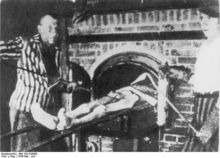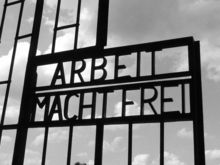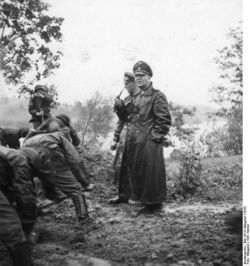| On this page |
|---|
| Word Browser |
| Theodor Eicke | |
|---|---|
| 17 October 1892 – 26 February 1943 (1943-02-27) (aged 50) | |
 Theodor Eicke | |
| Nickname | Papa |
| Place of birth | Hudingen (Hampont), Alsace-Lorraine |
| Place of death | near Orelka, Soviet Union |
| Allegiance | |
| Service/branch | Waffen-SS |
| Years of service | 1909–1943 |
| Rank | |
| Commands held | |
| Battles/wars | World War I World War II |
| Awards | Ritterkreuz des Eisernes Kreuz mit Eichenlaub |
Theodor Eicke (17 October 1892 – 26 February 1943) was a German General of the SS, (Obergruppenführer), commander of the SS-Division (mot) Totenkopf of the Waffen-SS and one of the key figures in the establishment of concentration camps in Nazi Germany. His Nazi Party number was 114901 and his SS number was 2921. Together with SS-Obersturmbannführer Michael Lippert, Eicke executed SA Chief Ernst Röhm following the Night of the Long Knives.[1]
Early Life — World War I
Eicke, the son of a station master, was born in Hudingen (Hampont), near Château-Salins (then in the German province of Elsass-Lothringen) into a lower middle-class family. The youngest of 11 children, he did not do well in school and dropped out at the age of 17 before graduation. He joined the 23rd Bavarian Infantry Regiment as a volunteer; later on, in World War I, he took the office of paymaster for the 3rd — and, from 1916 on, the 22nd Bavarian Infantry Regiment. Eicke won the Iron Cross, Second Class in 1914 for bravery.
Eicke resigned from the army in 1919 with no prospect of finding work. He began studying in his wife's hometown of Ilmenau. However, he dropped out of school again in 1920 intending to pursue a police career. He initially worked as an informer and later as a regular policeman.
His career in the police came to an end, partly due to his lack of a school diploma, but also because of his fervent hatred for the Weimar Republic and his repeated participation in violent political demonstrations.
He finally managed to find work in 1923 at IG Farben in Ludwigshafen, soon rising to the rank of leader of the company's internal intelligence service.
Rise of the Nazi Party
Eicke's views on the Weimar Republic were very similar to the Nazi Party and so he joined the Nazis and Ernst Röhm's SA on 1 December 1928. He left the SA in August 1930 in favour of the SS, where he quickly rose in rank after recruiting new members and building up the SS organization in the Bavarian palatinate. He had been promoted to SS-Standartenführer (roughly equivalent to Colonel) by Heinrich Himmler by the end of 1931.
His political activities caught the attention of his employer and in early 1932 he was laid off by IG Farben. At the same time, he was caught preparing bomb attacks on political enemies in Bavaria for which he received a two year prison sentence in July 1932. However, due to protection received from Franz Gürtner, who would later become minister of justice under Adolf Hitler, he was able to escape the sentence and instead fled to Italy on an order from Heinrich Himmler, where he took over responsibility for a camp for exiled SS members.
SS and concentration camps

Eicke then returned to Germany in March 1933 following Hitler's rise to power. Eicke had political quarrels with Gauleiter Joseph Bürckel, who had him arrested and he spent several months in a mental asylum. Heinrich Himmler eventually had him released in June 1933. After promotion to an Oberführer, Eicke was made commandant of the Dachau concentration camp on June 26, after complaints and criminal proceedings against former commandant SS-Sturmbannführer Hilmar Wäckerle following the murder of several detainees under the "guise of punishment".[2]
Promoted on 30 January 1934 to SS-Brigadeführer (equivalent to Major-general in the Waffen-SS), Eicke as commander of Dachau began new reforms. He reorganized the SS camp, establishing new guarding provisions, which included blind obedience to orders, and tightening disciplinary and punishment regulations for detainees, which were adopted by all concentration camps of the Third Reich on 1 January 1934.
Eicke's radical anti-semitism and anti-bolshevism as well as his insistence on blind and unconditional obedience towards him as the camp's commander as well as the SS and Hitler made an impression on Himmler. And in May 1934, he was appointed Concentration Camps Inspector, a position which he began working in on 4 July 1934. Although technically responsible to the SS-Hauptamt, Eicke in fact reported directly to Himmler.

Eicke also was involved in the Night of the Long Knives at the end of June 1934; together with hand-chosen members of the Dachau concentration camp guards (SS-TV), he assisted Sepp Dietrich's SS-Leibstandarte Adolf Hitler to imprison SA commanders on June 30. To show his obedience to Himmler and Hitler, Eicke (together with his adjutant, Michael Lippert) shot Ernst Röhm on 1 July 1934. For this killing, Eicke was promoted again to SS-Gruppenführer. He is also alleged to have had a personal role in the killing of Erich Mühsam. As a result of the Night of the Long Knives, the remaining SA-run camps were taken over by the SS.
In his role as the Concentration Camps Inspector, Eicke began a large reorganisation of the camps in 1935, which consisted of the dismantling of the smaller camps. Dachau remained, then Sachsenhausen concentration camp opened in summer 1936, Buchenwald in summer 1937 and Ravensbrück (near Lichtenburg) in May 1939. There were other new camps in Austria, such as Mauthausen-Gusen concentration camp, opened in 1938. All SS camps' regulations, both for guards and prisoners, followed the Dachau camp model.
Eicke's reorganizations and the introduction of forced labour made the camps one of the SS's most powerful tools; this earned him the enmity of (among others) Reinhard Heydrich, who had already unsuccessfully attempted to take control of the Dachau concentration camp in his position as chief of the SD. Eicke prevailed with support from Himmler. When, in 1940, the Concentration Camps Inspectorate (CCI) was turned into Amt D of the SS-Wirtschafts-Verwaltungshauptamt under Oswald Pohl, he assured that the command structure he had introduced would not fall to the jurisdiction of the Gestapo and SD. The CCI and later Amt D were subordinate to the SD and Gestapo only in regards to who was admitted to the camps and who was released.[3] However, what happened inside the camps was under the command of Amt D.[3]
This and other things earned Eicke a fearsome reputation. Even within the SS, he was described as brutal, evil, distrustful, cruel, ambitious, and full of hatred for everyone who did not agree with Nazi ideology.
Eicke's attitude of "inflexible harshness" also influenced the guards in the concentration camps. Constant indoctrination removed any compassion for the detainees from the guards and created an atmosphere of controlled, disciplined cruelty that lived on even when Eicke was not involved with the concentration camps anymore. Among those who were influenced by Eicke in this way were Rudolf Höß, Franz Ziereis, Karl Otto Koch and Max Kögel.
Totenkopf Division
The success of the Totenkopf's sister formations the SS-Infanterie-Regiment (mot) Leibstandarte SS Adolf Hitler and the three Standarten of the SS-Verfügungstruppe led to Hitler approving Himmler's recommendation for the creation of three Waffen SS-divisions in October 1939.
Eicke's Totenkopf units were to form SS-Division Totenkopf and Eicke was given command. Totenkopf was to become one of the most effective German fighting formations on the Eastern Front, often serving as "Hitler's firemen", rushed to the scene of Soviet breakthroughs.
Eicke's career now deviated from Concentration Camps and he was not involved with the camp service after 1940. His replacement as Inspector of Concentration Camps was Richard Glücks who answered to Oswald Pohl in the SS Office of Economics and Administration.
During the course of the war, Eicke and his division became known for unmatched brutality and several war crimes, including the murder of British POWs in Le Paradis in 1940, the murder of captured Soviet soldiers and the plundering and pillaging of several Soviet villages.
The Totenkopf continued to show an unmatched ferocity, during the advance in 1941 as well as the summer offensive in 1942, the conquest of Kharkov, the Demyansk Pocket, and the defense of Warsaw and Budapest in early 1945. Eicke was a popular figure among his troops, gaining him the nickname "Papa Eicke".
Eicke was killed on 26 February 1943, several months after being promoted to SS-Obergruppenführer (equivalent to general in the Allgemeine SS and also General in the Waffen-SS). While performing a battlefield reconnaissance during the opening stages of the Third Battle of Kharkov, his Fieseler Fi 156 Storch was shot down by Soviet troops 1 kilometer southwest of Artelnoje (near Oryol). An assault group from the division recovered the bodies of Eicke, the pilot and SS-Hauptsturmführer Friedrich from enemy territory.[4] Eicke was portrayed in the Axis press as a hero, and soon after his death one of the Totenkopf's infantry regiments received the honorific cuff-title Theodor Eicke.
Personal life
Eicke married Bertha Schwebel on 26 December 1914. They had two children, Irma born on 5 April 1916 and Hermann, born on 4 May 1920 [1].
Summary of his military career
Dates of rank
- SS-Mann: July 29, 1930
- SS-Truppführer: August, 1930
- SS-Sturmführer: November 11, 1930
- SS-Sturmbannführer: January 30, 1931
- SS-Standartenführer: November 11, 1931
- SS-Oberführer: October 26, 1932
- SS-Brigadeführer: January 30, 1934
- SS-Gruppenführer: July 11, 1934 und Generaleutnant der Waffen-SS: September, 1941
- SS-Obergruppenführer und General der Waffen-SS: April 20, 1942
Notable decorations
- Eastern Front Medal (1942)
- Iron Cross Second and First (1940) Classes
- Clasp to the Iron Cross Second Class (1940)
- SS-Honour Ring
- Knight's Cross of the Iron Cross (1941)
- Oak Leaves (1942)
- Wound Badge in Silver
- Cross of Honor (1934)
- Golden Party Badge (1940)
- Bavarian Military Merit Cross 2nd Class (?)[5]
- Braunschweig War Merit Cross Second Class
- Mentioned in the Wehrmachtbericht on 21 October 1942
See also
References
- Andrew, Mollo. A Pictorial History of the SS, 1923–1945. ISBN 0-8128-2174-2.
- Kershaw, Ian (2008). Hitler: A Biography. W. W. Norton & Company, ISBN 0-393-06757-2.
- Lumsden, Robin. The Allgemeine-SS, Vol. 266. ISBN 1-85532-358-3.
- Padfield, Peter (2001). Himmler: Reichsführer-SS, Cassel & Co, London, (re-print) ISBN 0-304-35839-8.
- Schaulen, Fritjof (2003). Eichenlaubträger 1940–1945 Zeitgeschichte in Farbe I Abraham – Huppertz. Selent, Germany: Pour le Mérite. ISBN 3-932381-20-3. (German)
- Sydnor, Jr., Charles W. (1990). Soldiers of Destruction: the SS Death's Head Division, 1933-1945. Princeton University Press, ISBN 0-691-00853-1.
- Williams, Max (2003). Reinhard Heydrich: The Biography: Volumes 1, Ulric Publishing, ISBN 0-9537577-5-7.
- Yerger, Mark C.. Allgemeine-SS. ISBN 0-7643-0145-4.
Notes
- ^ Kershaw, Ian. Hitler (2008), p. 312.
- ^ Padfield, Peter. Himmler, (1990), pp. 128–129.
- ^ a b Williams, Max, Reinhard Heydrich: The Biography: Volume 1 (2003) p. 51.
- ^ Ullrich, Karl (2002). Like a Cliff in the Ocean: A History of the 3rd SS-Panzer-Division Totenkopf. JJ Fedorowicz. ISBN 0-921991-69-X.
- ^ Eicke was an Unterzahlmeister, assistant paymaster in World War I; this is the class customary for his rank, but sources offer bad translations such as "Bayerische Order of Merit 2. Klasse (WW I)"
| Military offices | ||
|---|---|---|
| Preceded by SS-Standartenführer Hilmar Wäckerle |
Commander of K.L. Dachau 26 June 1933 – 4 July 1934 |
Succeeded by SS-Oberführer Alexander Reiner |
| Preceded by none |
Commander of 3. SS-Panzer Division Totenkopf 14 November 1939 – 6 July 1941 |
Succeeded by SS-Obergruppenführer Matthias Kleinheisterkamp |
| Preceded by SS-Obergruppenführer Georg Keppler |
Commander of 3. SS-Panzer Division Totenkopf 21 September 1941 – 26 February 1943 |
Succeeded by SS-Obergruppenführer Hermann Prieß |
| ||||||||||||||||||||||||||||||||||||||||||||||||||||||||||||||||
| Persondata | |
|---|---|
| Name | Eicke, Theodor |
| Alternative names | |
| Short description | |
| Date of birth | 17 October 1892 |
| Place of birth | Hudingen (Hampont), Alsace-Lorraine |
| Date of death | 26 February 1943 |
| Place of death | near Orelka, Soviet Union |
Want to thank TFD for its existence? Tell a friend about us, add a link to this page, add the site to iGoogle, or visit the webmaster's page for free fun content.
Link to this page:
Please bookmark with social media, your votes are noticed and appreciated:
| ?Page tools | ||
|---|---|---|
|
| ?My Word List |
|---|
| Add current page to the list |
| ?Charity |
|---|
 Feed a hungry child - donate to school feeding program Feed a hungry child - donate to school feeding program |

